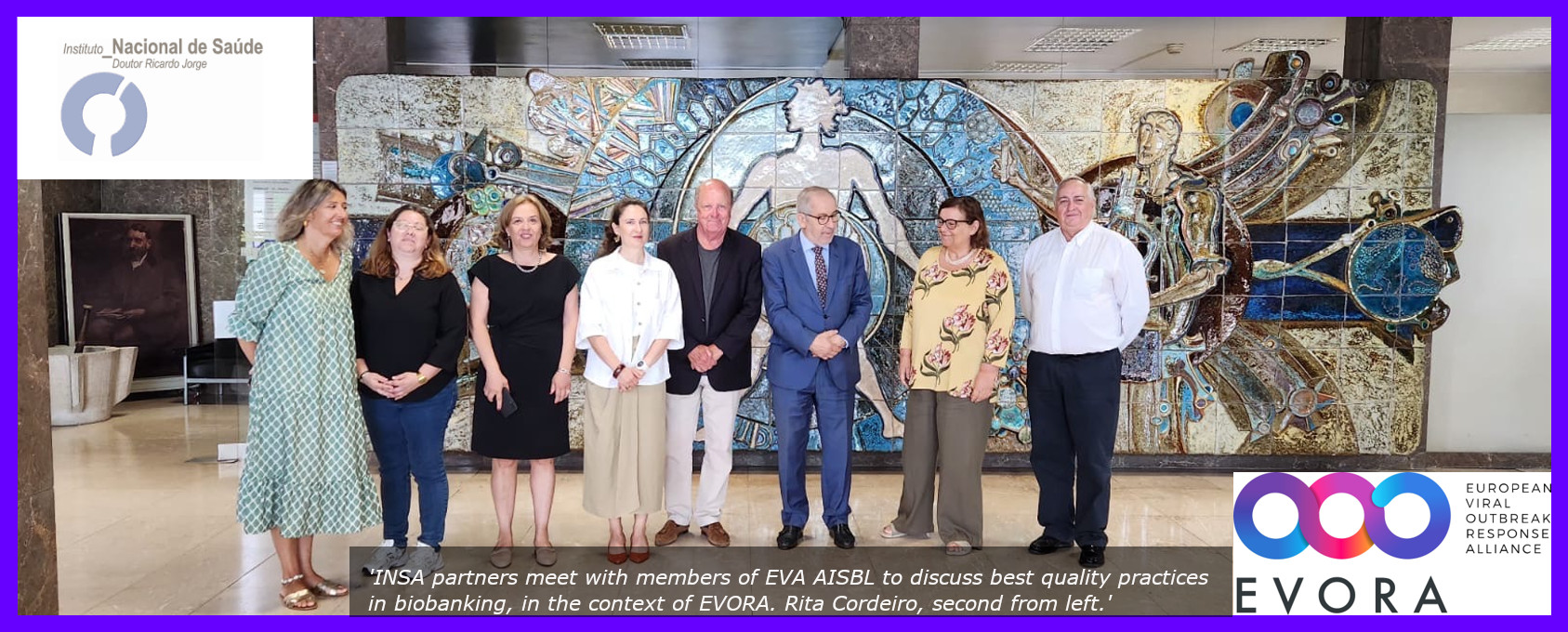Partners in EVORA
Meet Rita Cordeiro, scientist at the Department of Infectious Diseases at the National Institute of Health Dr. Ricardo Jorge (INSA) in Portugal.
Starting from Biotechnological Engineering, Rita did a Master’s degree in Clinical Microbiology and currently works at the Emergency Response and Biopreparedness Unit (UREB) within INSA, on the development, validation and implementation of molecular diagnostic methods for high-consequence viral pathogens in BSL-3 containment. Rita has over fifteen years of experience in biopreparedness, biosafety and biosecurity, and laboratory-based detection of emerging and re-emerging infectious diseases.
What brought you to the role/institute/project you are currently working on?
‘My journey at INSA began with an undergraduate internship in the Bacteriology Department, which later evolved into my Master’s thesis. During the 2009 H1N1 influenza pandemic, I joined the UREB, and have been working there ever since, focusing on preparedness, molecular diagnostics, and research related to re-emerging viral pathogens, such as viruses causing haemorrhagic fevers and monkeypox virus. Over the years, I have built extensive experience in biosafety and biosecurity, contributing to training of laboratory professionals, nationally and internationally, especially in the context of BSL-3 operations and the response to public health emergencies.
I am currently pursuing a PhD in Biology, investigating the potential threat posed by monkeypox virus and other Orthopoxviruses to public health in Portugal. Monkeypox virus is the only virus that is listed as a priority agent for detection in the event of a bioterrorism threat while having had confirmed cases in Portugal. This makes the topic not only scientifically relevant, but also highly significant from a public health and national preparedness perspective’, Rita highlights.
INSA…
As the National Laboratory for Health in Portugal, INSA acts as National Reference Laboratory and National Health Observatory, with the mission to generate knowledge and provide scientific and technical support to the Ministry of Health and stakeholders including the public health authorities, hospitals, universities, research institutions, and international bodies like the WHO and ECDC.
‘By doing so, we contribute to the formulation of health policies and evidence-based public health decisions’ , says Rita.
Research and development conducted by INSA covers multiple health science fields, including infectious and chronic diseases, genetics, environmental health, epidemiology, and health services.
The Department of Infectious Diseases supports public health through a broad range of activities, including specialized services and consultancy, laboratory-based epidemiological surveillance, and research on infectious diseases and their determinants. It also contributes to the national health research agenda, assesses biological risks during public health emergencies, and coordinates biobanks, animal facilities, and BSL-3 laboratories. These efforts aim to generate knowledge that enhances the prevention, diagnosis, treatment, and control of infectious diseases, ultimately contributing to their possible elimination.
…as part of EVORA
INSA participates in the EVORA project, an alliance between three research infrastructures (EVA, ERINHA, ELIXIR), aimed at strengthening European capabilities for pandemic preparedness and response.
‘Within EVORA, my role is to apply my technical expertise in biosafety, biosecurity, and diagnostic preparedness to support activities involving high-risk pathogens in BSL-3 environments; this includes the development and review of standard operating procedures, risk assessments and biosafety procedures, as well as training and capacity-building efforts. I also participate in the implementation of quality management practices aligned with ISO 15189 and ISO 35001, aiming to ensure analytical reliability, regulatory compliance, and continuous improvement in emergency laboratory workflows’, Rita explains.
What are some of your recent research projects?
‘My research aligns with the broader national and European effort to enhance laboratory preparedness and capacity for high-consequence pathogens. By improving diagnostic methodologies, ensuring biosafety and biosecurity standards, and contributing to pathogen surveillance and genomic characterization, our work at INSA directly supports public health responses and early warning systems.
During the MPX virus multi-country outbreak in 2022, I participated in the phylogenomic analysis of the outbreak strain and identified early signs of viral microevolution (Nature Medicine 2022). Our findings provided insights into the evolutionary trajectory of the monkeypox virus (MPXV) strain involved in the 2022 outbreak and helped clarify potential mechanisms and targets of human adaptation. The rapid evolution observed in this human MPXV suggests that whole-genome sequencing may offer sufficient resolution to trace transmission dynamics and viral spread, which was initially considered challenging for a double-stranded DNA virus presumed to evolve slowly. Combined with the real-time data-sharing strategy adopted during the outbreak, this type of study can help guide new outbreak control measures and future research directions.
Subsequently, in 2024, I contributed to a study (Emerging Microbes & Infections) exploring the genetic evolution and transmission dynamics of the MPXV during the second wave of the 2022–2023 outbreak in Portugal. Our results identified accelerated viral evolution and evidence of multiple introductions and transmission clusters within the country. Modelling efforts suggested that behavioural changes and early depletion of susceptible individuals among high-contact populations contributed significantly to the decline in cases. The findings emphasize the critical importance of timely behavioural interventions and risk communication in outbreak management.
My recent work also includes evaluating the suitability of different clinical samples for diagnostics, based on their viral load dynamics (Journal of Medical Virology, 2024). This work aimed at optimising diagnostic protocols, therefore contributing to public health surveillance.’
Consistent with the scope of EVORA, these activities contribute to a coordinated European framework for pandemic preparedness, helping build resilient health systems capable of detecting, responding to, and mitigating the impact of future infectious disease threats.
What do you find particularly interesting in your work?
‘Contributing to public health through applied science is highly rewarding, especially when laboratory results directly inform outbreak responses and guide national and international interventions. Being part of a multidisciplinary team that operates at the intersection of diagnostics, research, and biosafety makes the work dynamic and meaningful!’
On the other hand, managing high-pressure scenarios during outbreak situations can be very demanding. ‘Ensuring accurate and timely diagnostics, while maintaining rigorous safety and quality standards, often requires rapid coordination between stakeholders and sustained focus under stressful conditions’ Rita concludes.
--
Text adaptation by Semeli Platsaki, PhD
